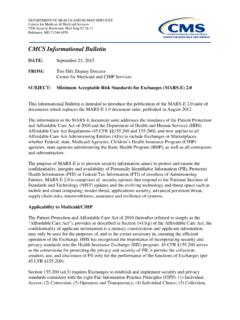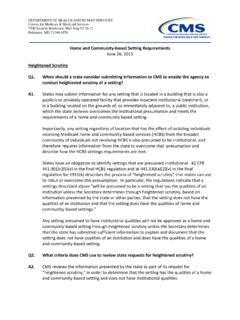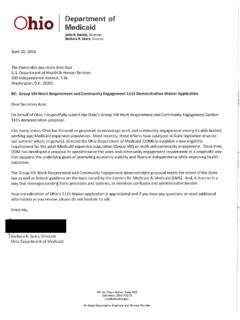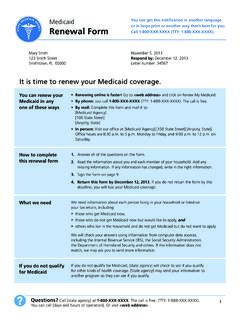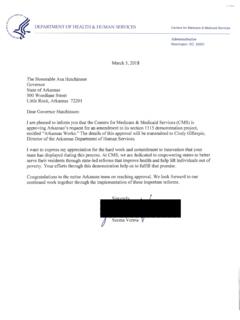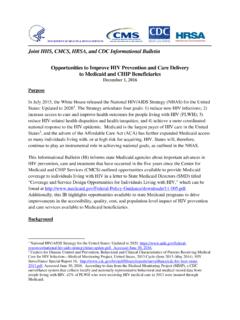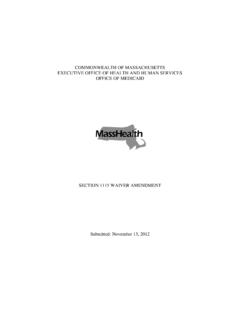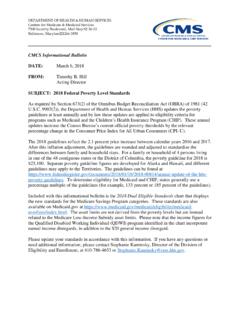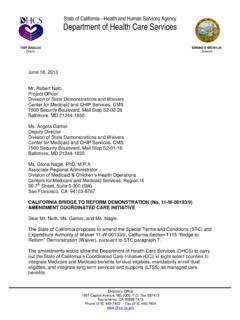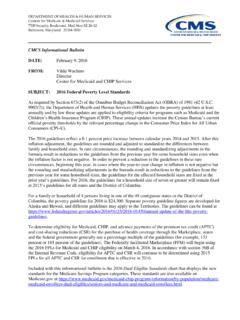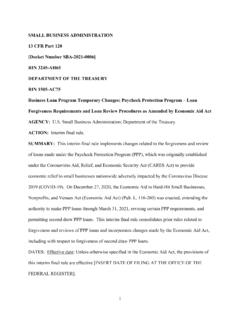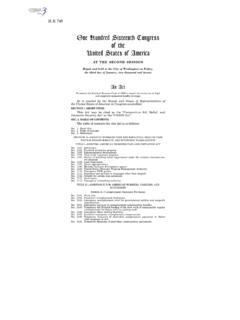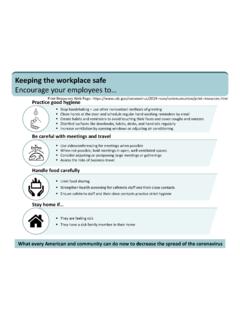Transcription of COVID-19 FAQs for State Medicaid and CHIP Agencies
1 Last Updated January 6, 2021 Page 1 of 161 COVID-19 Frequently Asked Questions (FAQs) for State Medicaid and Children s Health Insurance Program (CHIP) Agencies The Centers for Medicare & Medicaid Services (CMS) released six sets of general Frequently Asked Questions (FAQs) to aid State Medicaid and Children s Health Insurance Program (CHIP) Agencies in their response to the coronavirus disease 2019 ( COVID-19 ) pandemic. CMS also released two sets of FAQs providing guidance to states on the implementation of the families first coronavirus response Act (FFCRA) and the coronavirus Aid, Relief, and Economic Security (CARES) Act.
2 On January 6, 2021, CMS released an updated FAQ document that incorporates all eight sets of COVID-19 FAQs into one, comprehensive FAQ document. Additionally, on November 2, 2020, a provision implementing section 6008(b)(3) of the FFCRA in CMS-9912 Interim Final Rule with Comment (CMS-9912 IFC) became effective. CMS s original interpretation of the condition specified in section 6008(b)(3) was issued in FAQs in April, May and June 2020. While most of these FAQs remain in effect following the November 2, 2020 effective date of the IFC, some FAQs are applicable only through November 1, 2020.
3 Each of the previously published FAQs in Section of this document has been updated to respond to questions about section 6008(b)(3) of the FFCRA and includes a note with a designation of applicability related to the IFC. Table of Contents I. Emergency Preparedness and response .. 3II. Eligibility and Enrollment .. 8A. Application and Renewal Processing .. 8B. Premiums and Cost-Sharing .. 14C. Eligibility .. 20D. Notice and Fair Hearings .. 28E. Presumptive Eligibility .. 32F. Verification .. 35G. Basic Health Program .. 40H. Coverage for American Indians and Alaska Natives.
4 42I. Continuing Coverage under Section 6008 of the families first coronavirus response Act .. 43J. Children s Health Insurance Program (CHIP) .. 54K. Optional COVID-19 Testing Group .. 56L. Medically Needy and Post-Eligibility Treatment of Income/Transfer of Assets/Estate Recovery .. 64M. Expiration of Requirements for Claiming the Temporary FMAP Increase under Section 6008 of the FFCRA .. 65 III. Benefits .. 67A. COVID-19 Testing .. 67 Last Updated January 6, 2021 Page 2 of 161 B. Telehealth .. 71C. Home and Community Based Services.
5 76D. Pharmacy/Prescription Drugs .. 80E. Money Follows the Person (MFP) Program .. 83F. Miscellaneous .. 89G. Non-Emergency Medical 92H. Health Resources and Services Administration (HRSA) Uninsured Provider Fund/ Medicaid Coordination of Benefits .. 94IV. Financing .. 97A. Administrative Claiming .. 97B. Advance and Retainer Payments .. 98C. Federally Qualified Health Center (FQHC) and Rural Health Center (RHC) Services .. 105D. Payment Rates and Methodologies .. 106E. Upper Payment Limits .. 112F. FFCRA Temporary FMAP Increase .. 114G.
6 Increased Federal Match Rate under Section 6004 of the FFCRA .. 125H. Miscellaneous .. 128V. Managed Care .. 131A. Contracts and Rates .. 131B. Quality Measurement .. 141C. Miscellaneous .. 144VI. Information Technology .. 147A. Funding .. 147B. Health Information Exchange .. 149C. Transformed Medicaid Statistical Information System (T-MSIS) .. 150D. Telework .. 151E. Miscellaneous .. 152 VII. Miscellaneous .. 153A. Quality Reporting .. 153B. Workforce Issues .. 156C. 1115 Demonstrations .. 157D. Other .. 158 Last Updated January 6, 2021 Page 3 of 161 I.
7 Emergency Preparedness and response 1. What is the emergency period described in sections 6004 and 6008 of the families first coronavirus response Act (FFCRA)? Sections 6004 and 6008 of the FFCRA refer to the emergency period defined in section 1135(g)(1)(B) of the Social Security Act (the Act). Section 1135(g)(1)(B) of the Act defines the emergency period as the period during which there exists a public health emergency under section 319 of the Public Health Service Act for COVID-19 . The Health and Human Services (HHS) Secretary s public health emergency declaration for COVID-19 was effective on January 27, 2020, so the emergency period as defined in section 1135(g)(1)(B) began then, and continues through any renewal of the HHS Secretary s public health emergency The emergency period expires after 90 days, unless further extended by the Secretary.
8 The emergency period will terminate upon termination of the public health emergency, including any extensions. At the time the public health emergency period for COVID-19 ends, Centers for Medicare & Medicaid Services (CMS) will inform states. 2. What resources are available to assist states and territories in their response to COVID-19 ? Medicaid and the Children s Health Insurance Program (CHIP) play a critical role in helping states and territories respond to public health events, as well as natural and human-made disasters. To assist states and territories in their preparedness efforts, CMS developed a Disaster Preparedness Toolkit that is a longstanding resource that has been available to states and territories on CMS website, States and territories are encouraged to be familiar with this resource as part of their emergency preparedness planning.
9 The toolkit outlines numerous strategies available to support Medicaid and CHIP operations and enrollees in times of crisis, and serves as a comprehensive disaster preparedness resource for states and territories. Many of the flexibilities described in the toolkit will help states and territories in their response to COVID-19 . The toolkit is organized by operational areas, such as eligibility and enrollment, benefits, cost-sharing and provider workforce. The toolkit also outlines the legal authorities available to effectuate various strategies, including flexibilities in current statute, Medicaid and CHIP State plan amendments, section 1915(c) waiver Appendix K, and section 1115 demonstrations.
10 The toolkit also describes authority that may be granted through section 1135 waivers, which are only available when the President declares an emergency or natural disaster under the National Emergencies Act or Stafford Act and the Secretary declares a Public Health Emergency Declaration under Section 319 of the Public Health Service Act. The toolkit is available at: 1 The emergency period is defined in paragraph (1)(B) of section 1135(g) of the Act, as amended by 6074 The coronavirus Preparedness and response Supplemental Appropriations Act, 2020 (Pub.)
